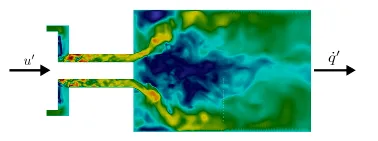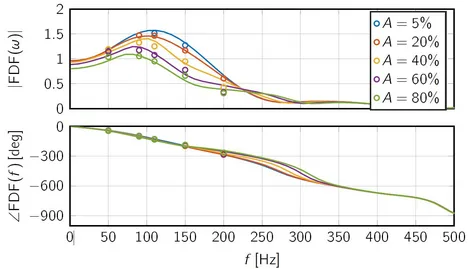Nonlinear Flame Dynamics
by Stefan Jaensch and Wolfgang Polifke
Motivation and Background
Thermoacoustic instabilities limit the development of gas turbines aimed to lower emission of pollutant and a higher operational flexibility. Thereby, a self-amplifying feedback between the acoustic waves, generated by the unsteady heat release rate of the flame and the acoustic waves reflected at other parts of the gas turbine, yields very high pressure and heat release oscillations. If the machine is not turned down, these oscillations can cause significant damage.
The occurrence of those instabilities in a gas turbine depends on the interaction of all parts of the engine. However, due to limited computational power, it is by no means possible to simulate a whole gas turbine within a large eddy simulation (LES). A method to overcome this problem is the so-called network approach. Thereby, the gas turbine is divided into several parts, e.g., the compressor, the combustion chamber, and the turbine. For each of these elements, a low-order model relating the input and output signals of the respective element is derived. Subsequently, all low-order models are interconnected to obtain a network model, which allows to predict the thermoacoustic stability of the gas turbine.
State of the art network models are linear and can, in general, predict unstable operating ranges. However, for the unstable regime, the linear analysis predicts an unbounded growth of the unstable eigenmodes of the system. In real configurations it is observed that the oscillation amplitudes increase until the assumption of linearity fails and nonlinear saturation effects come into play. Subsequently, the system reaches a limit cycle, if not turned down. In order to describe the occurring limit cycle, the nonlinear effects have to be modeled. The predominant nonlinear mechanisms in gas turbine combustion chambers are related to the flame dynamics. Therefore, objective of the present project is to find low-order models for the nonlinear dynamics of the flame.

Approach

The flame dynamics is considered as relation between a velocity fluctuation u’ upstream the flame and the resulting fluctuation of the global heat release rate q’, as shown in Fig. 1. It depends on many factors, e.g., geometry, mean flow velocity, and equivalence ratio. In order to account for all these effects, the low-order models are deduced from a LES of the flame. Therefore, the flame is first excited by means of a broadband high-amplitude signal and the resulting fluctuation of the heat release rate is measured. Afterwards, the time series obtained are post-processed by means of nonlinear system identification in order to obtain nonlinear models for the flame dynamics. Here, different black-box model structures like Volterra Series, Hammerstein-Wiener models, and artificial neural networks are investigated. Additionally, we invest how the knowledge of the flame dynamics can be utilized to obtain gray-box models.
The models identified should be able to describe the nonlinear flame dynamics over a large range of frequencies and amplitudes. In Fig. 2, the describing function of a nonlinear neural network and of the underlying CFD are compared and show good agreement. Please note, in order to obtain the describing function directly from the CFD, several simulations with harmonic forcing at different frequencies and amplitudes are necessary. With the system identification approach, it is possible to obtain the same information from data generated by a single CFD simulation. This reduces the computational cost significantly.
Acknowledgement

The financial support by the Research Association for Combustion Engines (Forschungsvereinigung Verbrennung e.V - FVV, project number: 6011150) is gratefully acknowledged.